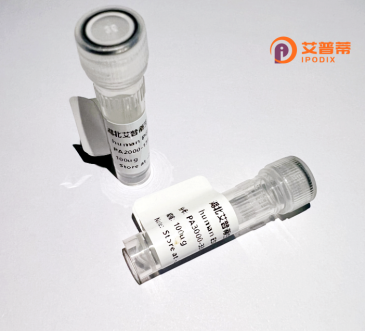
| 纯度 | >90%SDS-PAGE. |
| 种属 | Human |
| 靶点 | SPSB3 |
| Uniprot No | Q6PJ21 |
| 内毒素 | < 0.01EU/μg |
| 表达宿主 | E.coli |
| 表达区间 | 1-355aa |
| 活性数据 | MARRPRNSRA WHFVLSAARR DADARAVALA GSTNWGYDSD GQHSDSDSDP EYSTLPPSIP SAVPVTGESF CDCAGQSEAS FCSSLHSAHR GRDCRCGEED EYFDWVWDDL NKSSATLLSC DNRKVSFHME YSCGTAAIRG TKELGEGQHF WEIKMTSPVY GTDMMVGIGT SDVDLDKYRH TFCSLLGRDE DSWGLSYTGL LHHKGDKTSF SSRFGQGSII GVHLDTWHGT LTFFKNRKCI GVAATKLQNK RFYPMVCSTA ARSSMKVTRS CASATSLQYL CCHRLRQLRP DSGDTLEGLP LPPGLKQVLH NKLGWVLSMS CSRRKAPVSD PQAATSAHPS SREPRPCQRK RCRRT |
| 分子量 | 39.3 kDa |
| 蛋白标签 | His tag N-Terminus |
| 缓冲液 | PBS, pH7.4, containing 0.01% SKL, 1mM DTT, 5% Trehalose and Proclin300. |
| 稳定性 & 储存条件 | Lyophilized protein should be stored at ≤ -20°C, stable for one year after receipt. Reconstituted protein solution can be stored at 2-8°C for 2-7 days. Aliquots of reconstituted samples are stable at ≤ -20°C for 3 months. |
| 复溶 | Always centrifuge tubes before opening.Do not mix by vortex or pipetting. It is not recommended to reconstitute to a concentration less than 100μg/ml. Dissolve the lyophilized protein in distilled water. Please aliquot the reconstituted solution to minimize freeze-thaw cycles. |
以下是3篇关于SPSB3蛋白的相关文献摘要信息:
1. **"Structural basis for recognition of SOCS3 by the SPSB3 ubiquitin ligase component"**
- 作者:Liau N.P. et al. (2016)
- 摘要:解析了SPSB3蛋白的晶体结构及其与SOCS3相互作用的结构基础,揭示其通过SPRY结构域特异性结合靶蛋白的分子机制。
2. **"SPSB3 promotes melanoma growth via stabilizing EGFR signaling"**
- 作者:Lin Y. et al. (2019)
- 摘要:研究证明重组SPSB3在黑色素瘤细胞中过表达可通过抑制EGFR泛素化降解促进肿瘤增殖,提示其在癌症治疗中的潜在靶点作用。
3. **"SPSB3-mediated regulation of innate immune responses in macrophages"**
- 作者:Kershaw N.J. et al. (2017)
- 摘要:探讨了SPSB3通过调控TRAF6泛素化通路负向调节巨噬细胞TLR信号传导的机制,影响炎症因子释放和抗感染免疫应答。
以上文献涵盖SPSB3的结构解析、癌症调控及免疫调节功能,均为重组蛋白应用研究提供了关键依据。如需具体DOI或期刊请进一步说明。
The SPRY domain-containing SOCS box protein 3 (SPSB3) is a member of the SPSB family, which belongs to the larger ubiquitin-proteasome system regulating protein stability and signaling pathways. Structurally, SPSB3 contains a C-terminal SOCS box domain that interacts with E3 ubiquitin ligase complexes and an N-terminal SPRY domain responsible for substrate recognition. It acts as an adaptor protein, targeting specific substrates for proteasomal degradation by bridging them with E3 ligases.
SPSB3 is notably involved in modulating cellular processes such as immune response, apoptosis, and cell proliferation. It binds to inducible nitric oxide synthase (iNOS), promoting its ubiquitination and degradation, thereby regulating nitric oxide production in inflammatory and immune contexts. Dysregulation of SPSB3 has been linked to diseases like cancer and autoimmune disorders, where its role in protein turnover intersects with pathological signaling.
Recombinant human SPSB3 is typically produced in expression systems (e.g., *E. coli* or mammalian cells) for functional studies. Its application spans mechanistic research on protein degradation pathways, drug discovery targeting ubiquitination processes, and exploration of therapeutic strategies for diseases linked to SPSB3 dysfunction. Studies continue to uncover its interactions with other signaling molecules, underscoring its importance in cellular homeostasis and disease pathogenesis.
×